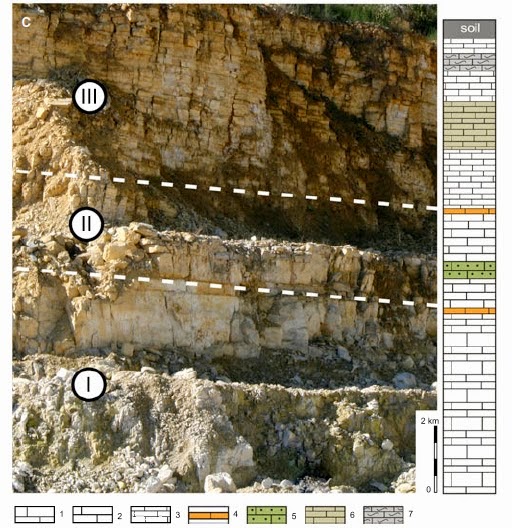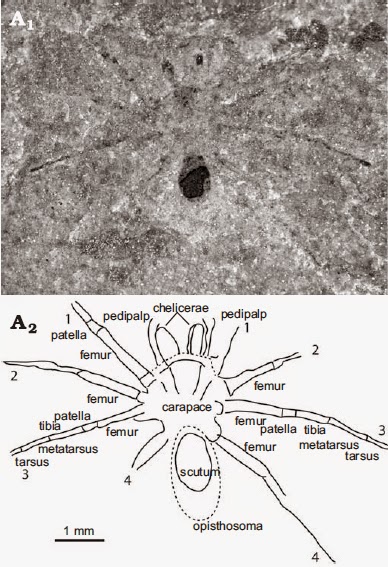Horseshoe Crabs, Xiphosurida, first appeared in the fossil record
during the Ordovician, at least 480 million years ago, and are still found
today in Southeast Asia and along the east coast of North America. They are not
true Crabs, nor even Crustaceans, but a distinct group of Arthropods related to
the extinct Trilobites and terrestrial Arachnids (Spiders, Scorpions and Mites
etc.). The group are remarkably morphologically conservative, having changed
very little since they first appeared, and even less since the early Mesozoic,
when forms very similar to those alive today first appeared.
In a paper published in the journal PLoS One on 2 October 2014, AdrianKin of the Society of Friends of Earth Sciences in Warsaw and Błażej Błażejowski
of the Institute of Paleobiology at the Polish Academy of Sciences, describe a
new species of Horseshoe Crab from the Late Jurassic Kcynia Formation at the
Owadów-Brzezinki Quarry in Central Poland.
The new species is placed in the extant genus Limulus and given the specific name darwini, in honour of the Victorian naturalist and evolutionary
biologist Charles Darwin (1809-1882). The species is described from nine
specimens, although these all preserve only the dorsal surface, and are thought
to be moulted exoskeletons of juveniles. Kin and Błażejowski note that such
moulted exoskeletons are the most common form of Xiphosurid fossils
encountered, and that most are from juveniles rather than adult specimens; the
Crabs keep growing for their entire lives, but have a distinct juvenile phase
when they grow rapidly and moult several times a year, followed by an adult
phase when they grow much more slowly and typically moult only once per year.
Three-dimensionally preserved representative of the
Late Jurassic Limulus darwini, preserved
as slightly compressed and juxtapositioned prosoma and opisthosoma. Kin & Błażejowski
(2014).
Although only the dorsal surface of Limulus darwini is preserved, this is remarkably similar to the
modern Limulus polyphemus from the
east coast of North America, to a degree that Kin and Błażejowski feel merits
explanation.
Comparison of modern Limulus polyphemus (left) and oldest known member of the genus Limulus darwini (right) fromCorbulomima horizon of unit III from
Late Jurassic (upper Tithonian = Middle Volgian) sedimentary sequence at Owadów-BrzezinkiQuarry
(central Poland). (X), (Y) and (Z) – details emphasized, are most substantial
morphological difference between both these forms. (cl) -cardiac lobe; (opr) –
opisthosomal rim; (pa) – posterial area.Morphological elements of L. darwini exoskeleton not known from
the fossil record (i.e.movable spines and telson) emphasized in grey. Kin & Błażejowski
(2014).
Kin and Błażejowski note that while Horseshoe Crabs show remarkable
morphological conservatism, they are in many ways strikingly flexible
organisms. All four modern species are highly tolerant of wide fluctuations in
temperature and salinity; the North American Limulus polyphemus lives happily in waters as cool as 1˚C off the
coast of Maine and as warm as 30˚C off the coasts of Florida and Mexico, while
the Asian Carcinoscorpius rotundicaudata
migrates around 150 km up the Hooghly River from fully marine to fully
freshwater conditions.
Horseshoe Crabs are also remarkably broad in their dietary habits.
Most species prey predominantly on Bivalves, but also eat a variety of Worms
and Snails, and will feed on a wide range of invertebrates, such as Echinoderms
and Crustaceans, when they are available, and will even consume small Fish and
plant material.
The precise ecology of extinct organisms is always subject to
debate, but the fossils of the Owadów-Brzezinki Quarry are dominated by
Bivalves of the genus Corbulomima,
which is also believed to have been tolerant of wide fluctuations in salinity
(many of its closest living relatives exhibit this trait) and which also
produces fossils of fully marine species such as Ammonites, and a variety of
terrestrial fossils, such as Grasshoppers and Beetles, suggesting at least
periodic inundations with freshwater
Horseshoe Crabs are also known from the Solnhofen Limestone in
Germany, deposits roughly contemporaneous with those at Owadów-Brzezinki, where
the exceptionally high preservation of the fossils has been linked to high
salinity in lagoons, which excluded detritavores that might have preyed on the
dead animals.
This suggests that two of the survival traits seen in modern
Horseshoe Crabs, a tolerance of changing water salinity and a diet based upon
(usually widely available) Bivalves but combined with a willingness to switch
to other prey, were already seen in the group in the Jurassic.
Kin and Błażejowski also note that while Horseshoe Crabs show
unusually little morphological variation, they show typical levels of genetic
variation for more variable species, suggesting that individual Crabs vary in
their environmental tolerances; this can be an advantage in times of
environmental crises, as it makes it more likely that some members of a group
will always survive.
Finally Kin and Błażejowski observe that the blood of Horseshoe
Crabs is known to have remarkable anti-bacterial properties, a trait shared with
other groups that have changed relatively little for very periods of time, such
as Sharks and Crocodiles.
Horseshoe Crabs are members of a diverse group or organisms known
popularly as ‘living fossils’, which also includes groups such as Lingulid
Brachiopods and Ginko Trees. However Kin and Błażejowski feel that this term is
somewhat imprecise, as it also includes relict members of ancient groups such
as the Ceolocanth Latimaria and the
Nautilid Nautilus, which are not
particularly similar to earlier members of the same groups. Instead they
propose the adoption of a new term ‘stabilomorphism’, to describe species that
have remained essentially similar in form for periods in excess of 65 million
years (a definition which would also include fossil groups that remained stable
for long periods of time but which have no living representatives)
See also…
The term lagerstätte is used by Palaeontologists to describe a
particularly rich fossil source; a site where fossils are either
exceptionally numerous or exceptionally well preserved (or, ideally,
both). One of the best known of these is the Solnhofen Limestone, or
Solnhofen Plattenkalk, which formed in the early Tithonian, towards the
end of the Jurassic, as a result of intense global...
Mygalomorph Spiders (Tarantulas and related species) are considered to
be one of the most ancient groups of Spiders. They have two pairs of
book lungs (many other Spiders have lost a pair) and downward pointing,
rather than opposable fangs, again considered to be a primitive state in
Spiders. Many species of Mygalomorph attain large sizes, all have
flattened, disk-shaped bodies (rather than the more globular bodies of
most other Spiders), and most are ambush predators.
Trilobites were a group of Arthropods that flourished throughout the Palaeozoic, but died out at the end of the Permian. They are abundant and well studied fossils, but little is known of their internal anatomies.
Trilobites were a group of Arthropods that flourished throughout the Palaeozoic, but died out at the end of the Permian. They are abundant and well studied fossils, but little is known of their internal anatomies.
Follow Sciency Thoughts on Facebook.





